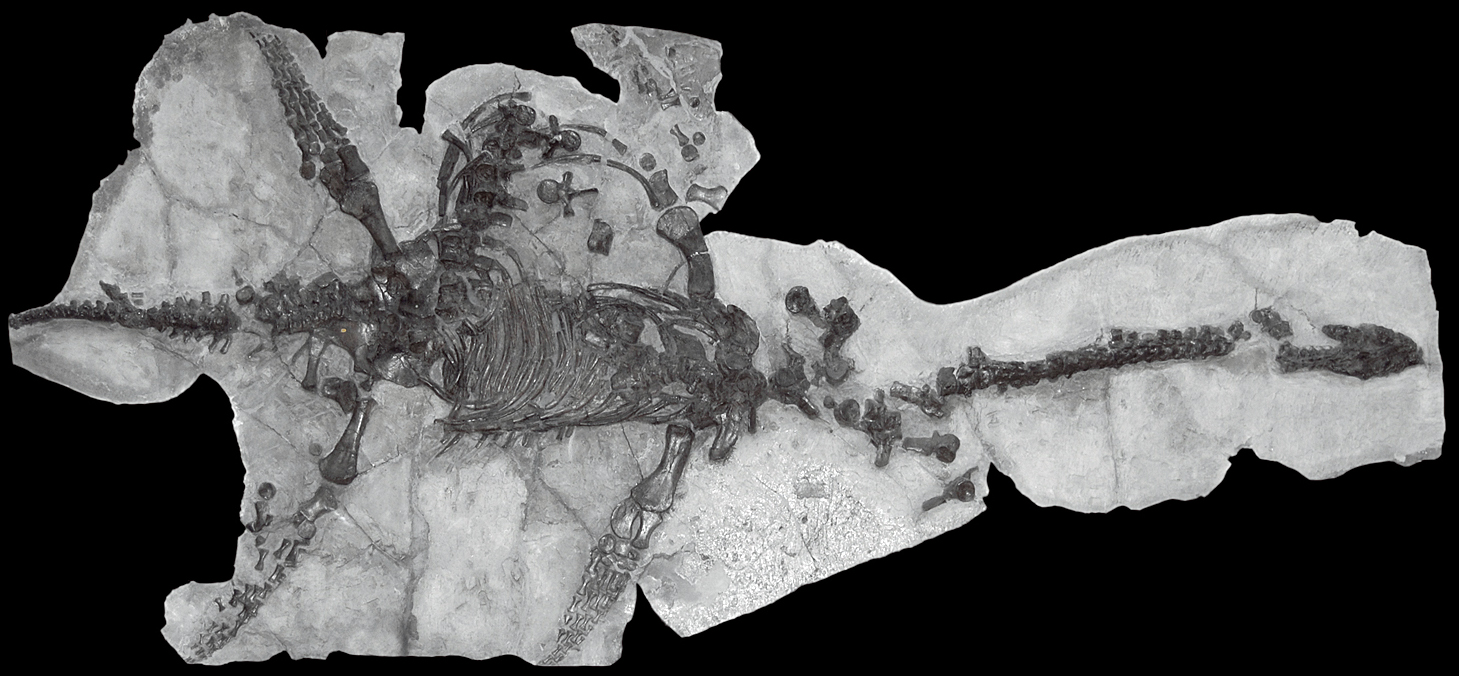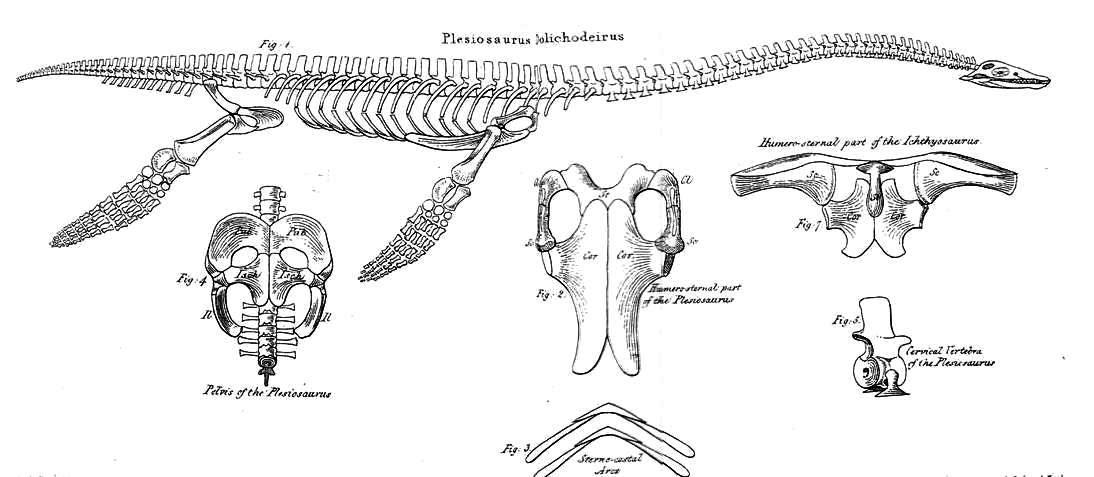|
Sauropterygia
Sauropterygia ("lizard flippers") is an extinct taxon of diverse, aquatic diapsid reptiles that developed from terrestrial ancestors soon after the end-Permian extinction and flourished during the Triassic before all except for the Plesiosauria became extinct at the end of that period. The plesiosaurs would continue to diversify until the end of the Mesozoic, when they became extinct as part of the end-Cretaceous mass extinction. Sauropterygians are united by a radical adaptation of their pectoral girdle, adapted to support powerful flipper strokes. Some later sauropterygians, such as the pliosaurs, developed a similar mechanism in their pelvis. Other than being diapsids, their affinities to other reptiles have long been contentious. Sometimes suggested to be closely related to turtles, other proposals have considered them most closely related to Lepidosauromorpha or Archosauromorpha, and/or the marine reptile groups Thalattosauria and Ichthyosauromorpha. Origins an ... [...More Info...] [...Related Items...] OR: [Wikipedia] [Google] [Baidu] |
Plesiosauria
The Plesiosauria or plesiosaurs are an order or clade of extinct Mesozoic marine reptiles, belonging to the Sauropterygia. Plesiosaurs first appeared in the latest Triassic Period, possibly in the Rhaetian stage, about 203 million years ago. They became especially common during the Jurassic Period, thriving until their disappearance due to the Cretaceous–Paleogene extinction event at the end of the Cretaceous Period, about 66 million years ago. They had a worldwide oceanic distribution, and some species at least partly inhabited freshwater environments. Plesiosaurs were among the first fossil reptiles discovered. In the beginning of the nineteenth century, scientists realised how distinctive their build was and they were named as a separate order in 1835. The first plesiosaurian genus, the eponymous '' Plesiosaurus'', was named in 1821. Since then, more than a hundred valid species have been described. In the early twenty-first century, the number of discoveries ... [...More Info...] [...Related Items...] OR: [Wikipedia] [Google] [Baidu] |
Plesiosaur
The Plesiosauria or plesiosaurs are an Order (biology), order or clade of extinct Mesozoic marine reptiles, belonging to the Sauropterygia. Plesiosaurs first appeared in the latest Triassic Period (geology), Period, possibly in the Rhaetian stage, about 203 million years ago. They became especially common during the Jurassic Period, thriving until their disappearance due to the Cretaceous–Paleogene extinction event at the end of the Cretaceous Period, about 66 million years ago. They had a worldwide oceanic distribution, and some species at least partly inhabited freshwater environments. Plesiosaurs were among the first fossil reptiles discovered. In the beginning of the nineteenth century, scientists realised how distinctive their build was and they were named as a separate order in 1835. The first plesiosaurian genus, the eponymous ''Plesiosaurus'', was named in 1821. Since then, more than a hundred valid species have been described. In the early twenty-first cent ... [...More Info...] [...Related Items...] OR: [Wikipedia] [Google] [Baidu] |
Hanosaurus
''Hanosaurus'' is an extinct genus of marine reptiles that existed during the Triassic period in what is now China. The type species is ''Hanosaurus hupehensis''. It was a small animal, with specimens measuring long in total body length, which likely fed on soft-bodied prey. Discovery ''Hanosaurus'' (lizard of Han River) was discovered from the Sonshugo locality of Hubei, China. It was found at the second member of the Jialingjiang Formation. The type specimen consisted of a skull, complete hindlimbs and pelvis, incomplete shoulder girdle represented by coracoid and clavicle, and an articulated but incomplete vertebral column. It was initially described as a thalattosaur but subsequent research showed it was more likely to be a sauropterygia. A more complete referred specimen was described in 2022 from the Yingzishan locality of Hubei, China. The specimen was also found at the second member of the Jialingjiang formation. It consisted of almost the entire skeleton preserved w ... [...More Info...] [...Related Items...] OR: [Wikipedia] [Google] [Baidu] |
Saurosphargidae
Saurosphargidae is an extinct family of marine reptiles known from the Early Triassic (Olenekian stage) and early Middle Triassic (Anisian stage) of Europe and China. The type genus of the family is '' Saurosphargis'', named by Friedrich von Huene in 1936 based on a single specimen collected from the lower Anisian Lower Muschelkalk of Gogolin, Poland -- a section of 12 incomplete back vertebrae with ribs. The generic name of ''Saurosphargis'' is derived from Greek ''sauros'', "lizard," and ''sphargis'', the old genus name for the leatherback turtle, in reference to the dorsal osteoderm "body armor" and broadened ribs forming a closed chest rib basket, traits that are seemingly transitional between turtles and other reptiles. However, due to the only known specimen' destruction during World War II, many authors considered ''Saurosphargis'' to be a ''nomen dubium''. Nevertheless, even based on surviving descriptions alone, many differences were noted even from its closest known ... [...More Info...] [...Related Items...] OR: [Wikipedia] [Google] [Baidu] |
Aristonectes
''Aristonectes'' (meaning "best swimmer") is an extinct genus of large elasmosaurid plesiosaurs that lived during the Maastrichtian stage of the Late Cretaceous. Two species are known, ''A. parvidens'' and ''A. quiriquinensis'', whose fossil remains were discovered in what are now Patagonia and Antarctica. Throughout the 20th century, ''Aristonectes'' was a difficult animal for scientists to analyze due to poor fossil preparation, its relationships to other genera were uncertain. After subsequent revisions and discoveries carried out from the beginning of the 21st century, ''Aristonectes'' is now recognised as the type genus of the subfamily Aristonectinae, a lineage of elasmosaurids characterized by an enlarged skull and a reduced length of the neck. Measuring more than long, ''Aristonectes'' is a notably imposing plesiosaur. A referred specimen discovered in Antarctica has an estimated size of more than long, which would make this genus one of the largest known plesiosa ... [...More Info...] [...Related Items...] OR: [Wikipedia] [Google] [Baidu] |
Nothosaur
Nothosaurs (superfamily Nothosauroidea) were Triassic marine sauropterygian reptiles. They averaged about in length, with a long body and tail. The feet were paddle-like, and are known to have been webbed in life, to help power the animal when swimming. The neck was quite long, and the head was elongated and flattened, and relatively small in relation to the body. The margins of the long jaws were equipped with numerous sharp outward-pointing teeth, indicating a diet of fish and squid. Taxonomy The Nothosauroidea has been suggested to consist of two suborders, the Pachypleurosauria, which are small primitive forms, and the Nothosauria (including two families Nothosauridae and Simosauridae), which may have evolved from pachypleurosaurs. The relation of pachypleurosaurs to Nothosauroidea is uncertain, as several analyses recover the clade as basal to Eusauropterygia, e.i. the clade formed by Nothosauria and Pistosauroidea, instead as the sister taxon of Nothosauria. Many recen ... [...More Info...] [...Related Items...] OR: [Wikipedia] [Google] [Baidu] |
Placodontia
Placodonts ("Tablet (pharmacy), tablet tooth, teeth") are an Extinction, extinct order (biology), order of marine reptiles that lived during the Triassic period, becoming extinct at the end of the period. They were part of Sauropterygia, the group that includes Plesiosauria, plesiosaurs. Placodonts were generally between in length, with some of the largest measuring long. The first specimen was discovered in 1830. They have been found throughout central Europe, North Africa, the Middle East and China. Palaeobiology The earliest forms, like ''Placodus'', which lived in the early to middle Triassic, resembled barrel-bodied lizards superficially similar to the marine iguana of today, but larger. In contrast to the marine iguana, which feeds on algae, the placodonts ate Mollusca, molluscs and so their teeth were flat and tough to crush shells. In the earliest periods, their size was probably enough to keep away the top sea predators of the time: the sharks. However, as time passe ... [...More Info...] [...Related Items...] OR: [Wikipedia] [Google] [Baidu] |
Pistosauroidea
Pistosauroidea is a group of marine reptiles within the superorder (biology), superorder Sauropterygia that first appeared in the latter part of the Early Triassic and were the ancestors of plesiosaurs. Pistosauroids are rare in Triassic marine assemblages, and are represented by only a few fossils from central Europe, the United States, and China. Recent phylogenetic analyses consider the Triassic pistosauroids to be a paraphyletic grouping, meaning that they do not form a true clade. Plesiosauria is now placed within Pistosauroidea, while the traditional pistosauroids are successively more basal (phylogenetics), basal, or primitive, sauropterygians. Below is a cladogram of pistosauroid relationships from Cheng ''et al.'' (2006): Below is a cladogram of pistosauroid relationships from Ketchum & Benson, 2011: References Sauropterygia Early Triassic first appearances Maastrichtian extinctions {{paleo-reptile-stub ... [...More Info...] [...Related Items...] OR: [Wikipedia] [Google] [Baidu] |
Placodontiformes
Placodontiformes is an extinct clade of sauropterygian marine reptiles that includes placodonts and the non-placodont ''Palatodonta''. It was erected in 2013 with the description of ''Palatodonta''. Placodontiformes is the most basal (phylogenetics), basal clade of Sauropterygia and the sister taxon, sister group of Eosauropterygia, which includes all other sauropterygians. Phylogeny Below is a cladogram from Neenan ''et al.'' (2013) showing the position of Placodontiformes within Sauropterygia: References Placodontia {{triassic-reptile-stub ... [...More Info...] [...Related Items...] OR: [Wikipedia] [Google] [Baidu] |
Pachypleurosauria
Pachypleurosauria is an extinct clade of primitive sauropterygian reptiles from the Triassic period. Pachypleurosaurs vaguely resembled aquatic lizards, with elongate forms ranging in size from , with small heads, long necks, paddle-like limbs, and long, deep tails. The limb girdles are greatly reduced, so it is unlikely these animals could move about on land. The widely spaced peg-like teeth project at the front of the jaws, indicating that these animals fed on fish. In the species '' Prosantosaurus'', it was observed that they fed on small fishes and crustaceans which they devoured entirely and that its teeth regrew after they broke off. This was the first observation of tooth replacement in a European pachypleurosaur, with the only other discovery of such an event having been made in China. Classification Pachypleurosaurs were traditionally included within the Nothosauroidea (Carroll 1988, Benton 2004). In some more recent cladistic classifications, however, (Rieppel 2000), ... [...More Info...] [...Related Items...] OR: [Wikipedia] [Google] [Baidu] |
Pliosaur
Pliosauroidea is an extinct clade of plesiosaurs, known from the earliest Jurassic to early Late Cretaceous. They are best known for the subclade Thalassophonea, which contained crocodile-like short-necked forms with large heads and massive toothed jaws, commonly known as pliosaurs. More primitive non-thalassophonean pliosauroids resembled plesiosaurs in possessing relatively long necks and smaller heads. They originally included only members of the family Pliosauridae, of the order Plesiosauria, but several other genera and families are now also included, the number and details of which vary according to the classification used. The distinguishing characteristics are a short neck and an elongated head, with larger hind flippers compared to the fore flippers, the opposite of the plesiosaurs. They were carnivorous and their long and powerful jaws carried many sharp, conical teeth. Pliosaurs range from 4 to 10 meters or more in length. Their prey may have included fish, sharks, i ... [...More Info...] [...Related Items...] OR: [Wikipedia] [Google] [Baidu] |
Brachauchenius
''Brachauchenius'' (meaning 'short neck') is an extinct genus of pliosaurs that lived during the Late Cretaceous in what are now North America and North Africa. Only one species is known, ''B. lucasi'', initially described by Samuel Wendell Williston in 1903 from a partial fossil skeleton discovered in a quarry in Kansas, United States. Many other fossil specimens attributed to the species were subsequently discovered, including an individual from Morocco whose presence was made official in 2016. Many contemporary pliosaur specimens were formerly attributed to ''Brachauchenius'', but have since been reidentified as belonging to other genera or are recognized as Incertae sedis, indeterminate. Research history Holotype and naming In 1884, a partial skeleton of a marine reptile was discovered by the owner of a quarry near Delphos, Kansas, Delphos, in Ottawa County, Kansas. News of this find thus reached Charles H. Sternberg, who was then collecting fossils for Othniel Charles Marsh. ... [...More Info...] [...Related Items...] OR: [Wikipedia] [Google] [Baidu] |







